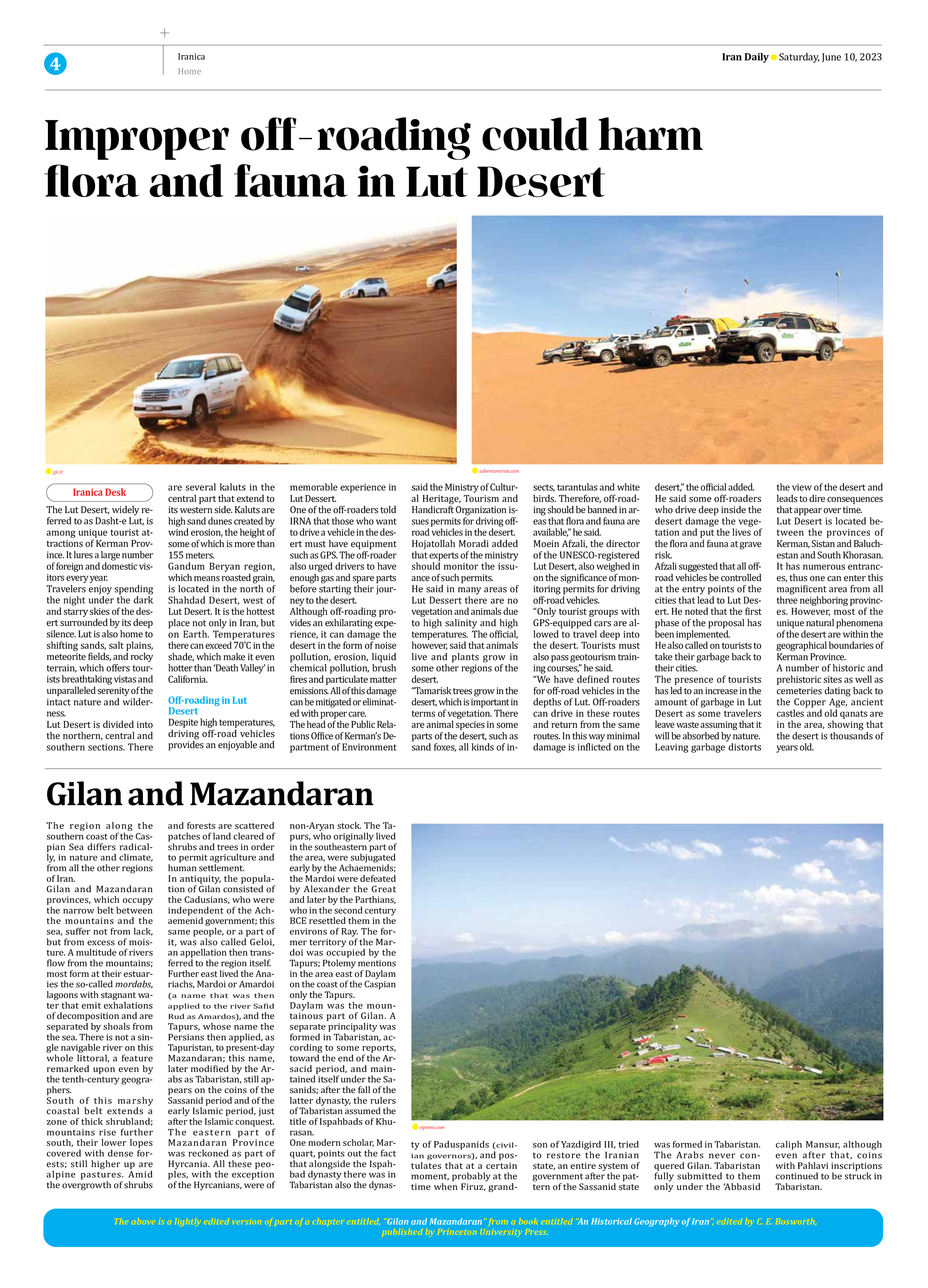
Improper off-roading could harm flora and fauna in Lut Desert
The Lut Desert, widely referred to as Dasht-e Lut, is among unique tourist attractions of Kerman Province. It lures a large number of foreign and domestic visitors every year.
Travelers enjoy spending the night under the dark and starry skies of the desert surrounded by its deep silence. Lut is also home to shifting sands, salt plains, meteorite fields, and rocky terrain, which offers tourists breathtaking vistas and unparalleled serenity of the intact nature and wilderness.
Lut Desert is divided into the northern, central and southern sections. There are several kaluts in the central part that extend to its western side. Kaluts are high sand dunes created by wind erosion, the height of some of which is more than 155 meters.
Gandum Beryan region, which means roasted grain, is located in the north of Shahdad Desert, west of Lut Desert. It is the hottest place not only in Iran, but on Earth. Temperatures there can exceed 70˚C in the shade, which make it even hotter than ‘Death Valley’ in California.
Off-roading in Lut Desert
Despite high temperatures, driving off-road vehicles provides an enjoyable and memorable experience in Lut Dessert.
One of the off-roaders told IRNA that those who want to drive a vehicle in the desert must have equipment such as GPS. The off-roader also urged drivers to have enough gas and spare parts before starting their journey to the desert.
Although off-roading provides an exhilarating experience, it can damage the desert in the form of noise pollution, erosion, liquid chemical pollution, brush fires and particulate matter emissions. All of this damage can be mitigated or eliminated with proper care.
The head of the Public Relations Office of Kerman’s Department of Environment said the Ministry of Cultural Heritage, Tourism and Handicraft Organization issues permits for driving off-road vehicles in the desert.
Hojatollah Moradi added that experts of the ministry should monitor the issuance of such permits.
He said in many areas of Lut Dessert there are no vegetation and animals due to high salinity and high temperatures. The official, however, said that animals live and plants grow in some other regions of the desert.
“Tamarisk trees grow in the desert, which is important in terms of vegetation. There are animal species in some parts of the desert, such as sand foxes, all kinds of insects, tarantulas and white birds. Therefore, off-roading should be banned in areas that flora and fauna are available,” he said.
Moein Afzali, the director of the UNESCO-registered Lut Desert, also weighed in on the significance of monitoring permits for driving off-road vehicles.
“Only tourist groups with GPS-equipped cars are allowed to travel deep into the desert. Tourists must also pass geotourism training courses,” he said.
“We have defined routes for off-road vehicles in the depths of Lut. Off-roaders can drive in these routes and return from the same routes. In this way minimal damage is inflicted on the desert,” the official added.
He said some off-roaders who drive deep inside the desert damage the vegetation and put the lives of the flora and fauna at grave risk.
Afzali suggested that all off-road vehicles be controlled at the entry points of the cities that lead to Lut Desert. He noted that the first phase of the proposal has been implemented.
He also called on tourists to take their garbage back to their cities.
The presence of tourists has led to an increase in the amount of garbage in Lut Desert as some travelers leave waste assuming that it will be absorbed by nature.
Leaving garbage distorts the view of the desert and leads to dire consequences that appear over time.
Lut Desert is located between the provinces of Kerman, Sistan and Baluchestan and South Khorasan. It has numerous entrances, thus one can enter this magnificent area from all three neighboring provinces. However, most of the unique natural phenomena of the desert are within the geographical boundaries of Kerman Province.
A number of historic and prehistoric sites as well as cemeteries dating back to the Copper Age, ancient castles and old qanats are in the area, showing that the desert is thousands of years old.







